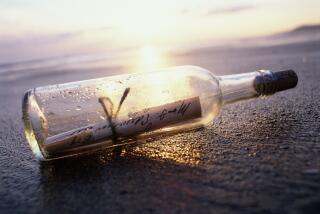FULLERTON : Pupils’ Sea Mail Drifts to Saipan
- Share via
Most people would be upset if their mail took three years to be delivered, but the children at Sunset Lane School were ecstatic.
In 1987, teacher Angelita Woodworth and a dozen third-graders studying Christopher Columbus stuffed a green wine bottle with handwritten letters, plugged it with a cork and gave it to woman going on a cruise to Mexico to toss into the Pacific Ocean. Three years passed, and the students assumed it was lost forever.
Then, on a sunny Saturday afternoon on the island of Saipan in the Pacific Ocean, a young attorney and his wife were walking along a rocky shore when they spotted a bottle.
Ted Gebhardt, a 27-year-old transplant from Minnesota, said the letters inside were faded, but still intact.
“This is the first time I ever found a note in the bottle. It seems like the romantic type of story that you always read in those pirate-type novels,” he said this week from his home in the Northern Marianas commonwealth.
Gebhardt said he had been searching for antique, blown-glass bottles used by Japanese fishermen as floats for their nets when he found the bottle, stranded by ebb tide on the craggy shore. He had to smash the bottle on a rock to get the notes, written in large penciled letters on wide-lined school paper.
“A lot of things can happen to a bottle out in the ocean. It could have hit up against the rocks at any one of the islands. The next high tide could have floated it off. I just happened to come along at the right time,” he said. “It just goes to show that if you take a chance, sometimes those things will pay off.”
Gebhardt returned the letters, along with one of his own and a thick, full-color book about his part of the Pacific. He, too, he said, had launched letters as a child; his were tied to balloons.
Gebhardt said he and his wife, Peggy, 28, decided to move to Saipan from Minnesota 2 1/2 years ago, during a cold snap.
“In Minnesota, it gets pretty rugged. It was 20 below and the snow was 36 inches deep. My wife has family (in Saipan) and we were looking at lots of old color photos” of the 43-square-mile volcanic island which is known as the “Bahamas of Japan.”
Woodworth said her students, now in sixth grade, could not believe that their letters had been returned.
“When I told them, ‘Here are your original letters,’ they just looked incredulous. One of them turned really red and said, ‘How could I write such a dumb letter?’ They were sent unedited, (including questions such as) ‘Are you mean?’ ” she said.
Twelve-year-old Brian Costales said that he would have written his letter differently if he had known who would receive it.
“I would have asked for money: ‘Dear lawyer, send $5,’ ” he joked.
It seems Woodworth could claim the title of the postmaster general of the seas. A previous class’ bottle that was tossed into the Atlantic Ocean near New York in 1986 made its way to Scotland within 18 months, she said. And in 1989, while on vacation in Denmark, Woodworth found a bottle on a beach that someone had sent from Germany.
Woodworth said the original idea to send a message by sea-mail came after the class read a story about Christopher Columbus.
“In that we found that Columbus had sent a letter in a box because he wasn’t sure he would make it back,” she said. “In one report, the letter was found 300 years later.”
Few of her students in 1987 thought that their bottle would really be found.
“They didn’t think that it would work. It was chancy to say the least,” she said.
Now, her current third-grade class is anxious to send its own messages in a bottle.
“My current class is getting jazzed up. They went to the library and checked out all the books they could get their hands on on Columbus. You won’t find any left. They’ve all got them,” she said.
More to Read
Sign up for Essential California
The most important California stories and recommendations in your inbox every morning.
You may occasionally receive promotional content from the Los Angeles Times.












